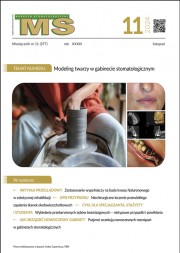Dostęp do tego artykułu jest płatny.
Zapraszamy do zakupu!
Po dokonaniu zakupu artykuł w postaci pliku PDF prześlemy bezpośrednio pod twój adres e-mail.
Bioactive Material Considerations for Vital Pulp‑Capping Procedures. CDEWorld. 2017 (1)
Mark L. Cannon, DDS, MS
Profesor w Oddziale Stomatologii Feinberg School of Medicine
Uniwersytetu Northwestern,
Wydział Otolaryngologii, Chicago, Illinois
Copyright © 2017 to Dental Learning Systems, LLC
All rights reserved. Reprinted with permission of the publishers
Copyright © for the Polish edition by “Magazyn Stomatologiczny”
Streszczenie
Prawidłowe zastosowanie procedur pokrycia miazgi zależy od wielu czynników, włącznie z wyborem odpowiednich materiałów. W ostatnich dwóch dekadach, producenci materiałów stomatologicznych skupili swoje zainteresowanie na rozwoju materiałów, które są biozgodne, bioaktywne, niecytotoksyczne i wspomagają tworzenie się mostu zębinowego. Obecnie są dostępne różne bioaktywne materiały do odbudowy, wspomagające remineralizację i hamujące demineralizację zębów. Ostatnio wprowadzone materiały do pokrycia miazgi zawierają krzemian wapnia, dzięki czemu wypełnienia stają się bardziej biomimetyczne, naśladują właściwości fizyczne zęba, stabilizują i ochraniają tkanki twarde. Artykuł stanowi przegląd rozwoju materiałów bioaktywnych do pokrycia miazgi w odpowiedzi na rosnące wymagania kliniczne.
Abstract
Performing successful pulp ‑capping procedures is predicated on many factors, including selecting appropriate materials. In the past two decades, dental product manufacturers have demonstrated significant interest in developing materials that are biocompatible, bioactive,
and non ‑cytotoxic and support dentin bridge formation. Today, a variety of bioactive dental restorative materials are available that promote remineralization and inhibit tooth demineralization.
More recently introduced bioactive pulp‑capping materials contain calcium silicate,
contribute to a more biomimetic restoration, mimic the physical characteristics of tooth
structure, and stabilize and protect dental hard tissues. This article reviews the development
of bioactive pulp‑capping materials in response to demanding clinical requirements.













